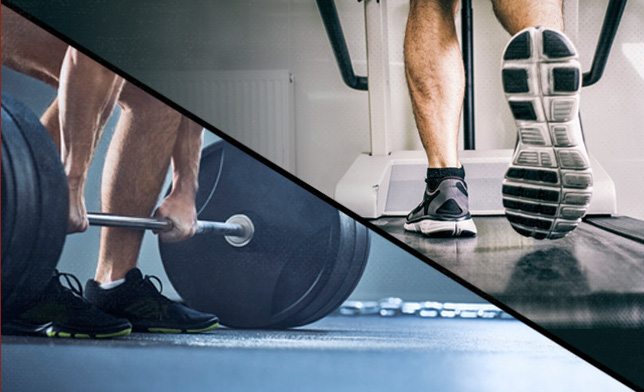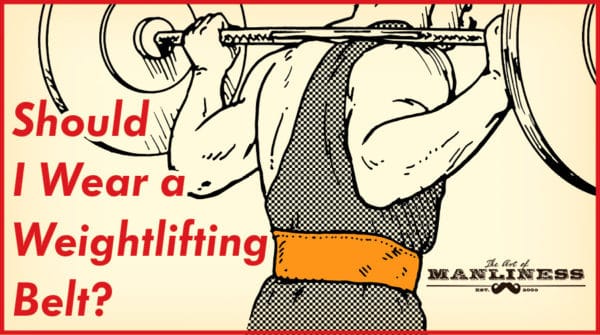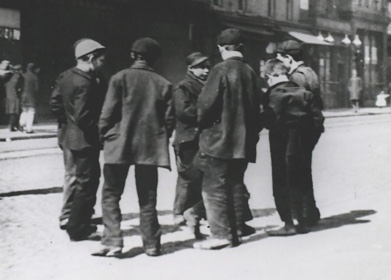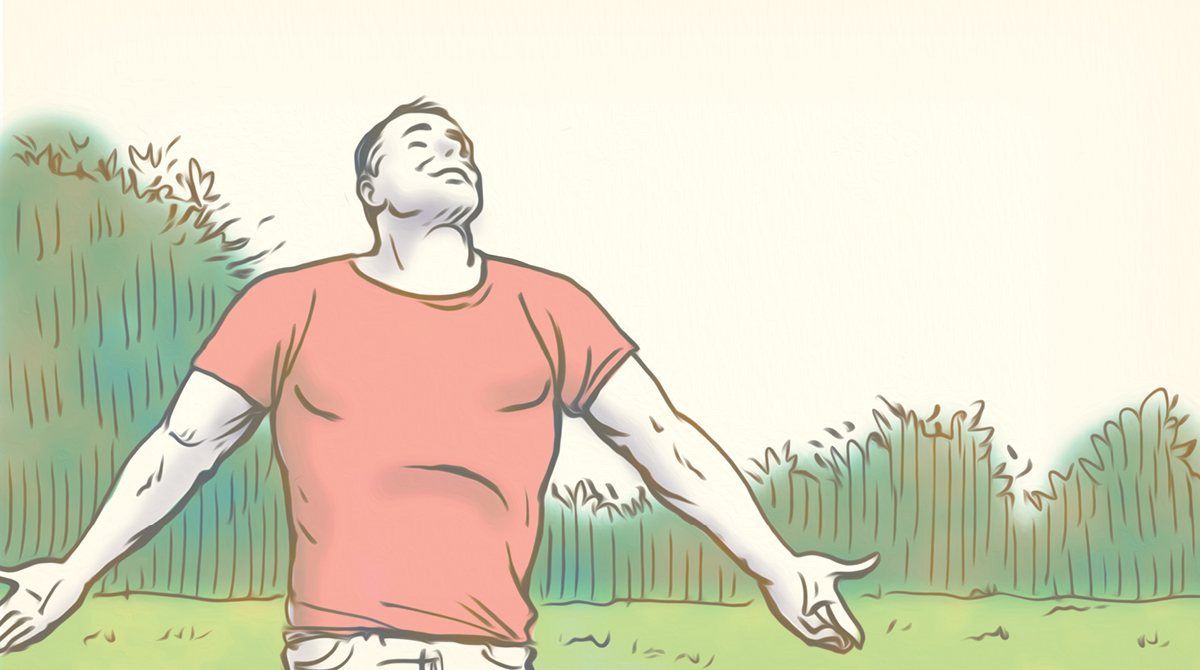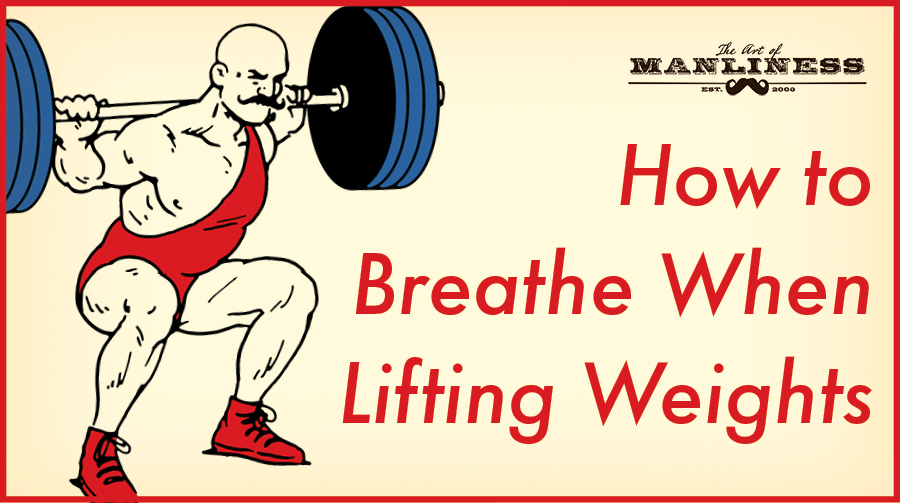
With our archives now 3,500+ articles deep, we’ve decided to republish a classic piece each Friday to help our newer readers discover some of the best, evergreen gems from the past. This article was originally published in September 2018.
When I started lifting weights back in high school, I was told that the proper way to breathe when doing it was to inhale while going down on the lift, and to exhale on the way up.
So when I squatted, I’d breathe in while I lowered my thighs to parallel to the ground, and breathe out as I rose up and straightened my legs out again.
I was told that it was important to breathe like this because it ensured my blood pressure didn’t get too high while hoisting all that weight, thus preventing me from passing out or having a stroke.
And so I thusly breathed while lifting weights for over a decade until I started working with Matt Reynolds, owner of Barbell Logic Online Coaching.
Instead of exhaling on the way out, he wanted me to hold my breath for the entirety of the rep.
“What in the name of Eugen Sandow?!” I exclaimed. “Won’t that cause me to black out?”
“No, and it protects your back when you’re performing heavy lifts,” Matt replied. “Breathing like this is called the Valsalva maneuver.”
“That’s a funny name, but tell me more.”
He did. I absorbed it all, changed up my breathing pattern, and have been a better lifter for it. Today I’ll pass on this know-how to you.
How to Perform the Valsalva Maneuver
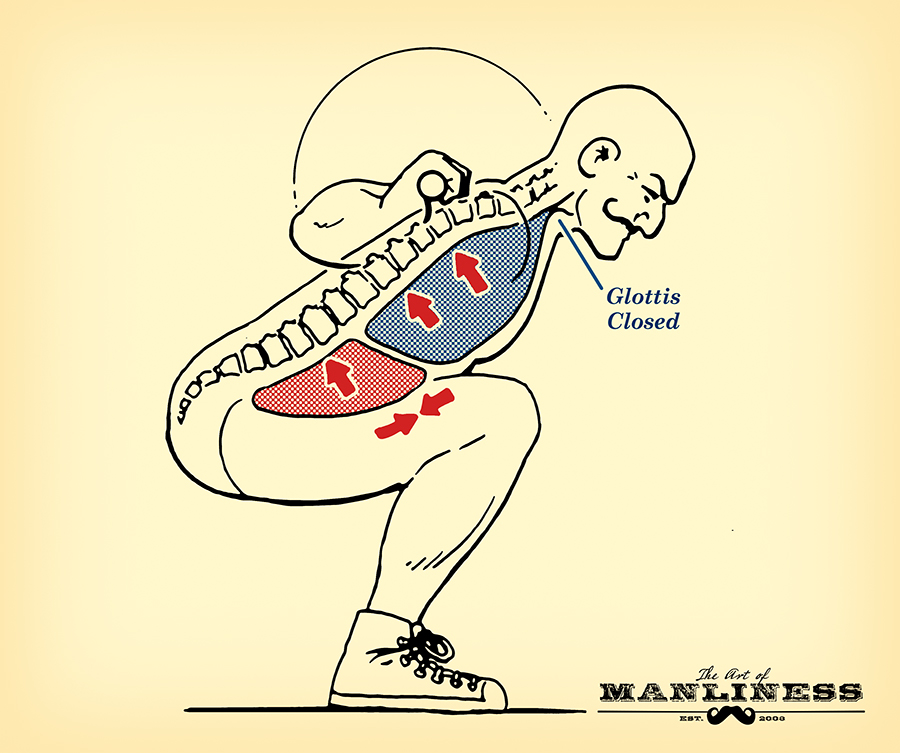
Illustration inspired by Starting Strength
Before you can understand the benefits of the Valsalva maneuver (which was named for a 17th century Italian physician), you need to know what’s involved in doing it. So let’s tackle that first.
1. Take a big belly breath. When you take your big breath, you want your belly to expand, but you don’t want your chest to get big. Think “breathe into my belly.” You’re not really breathing air into your belly. That’s just a cue for you to get the deep breath we’re looking for.
2. Close your glottis and exhale against it. The glottis is what allows air to go in and out of your windpipe when you breathe. When you close your glottis and exhale against it, air can’t escape your lungs, which in turn elevates intra-abdominal and intra-thoracic pressure. This provides your “core” the stability it needs to perform a heavy lift. More on this below.
3. Perform the entire lift while continuing to exhale against your closed glottis. Do not let air out while going down or when you’re coming back up with the lift. Keep exhaling against your closed glottis for the entirety of the lift.
4. Let the air escape from your glottis after the exertion. After you complete the rep, you can release the air from your glottis.
5. Repeat the process for the next rep.
Make sure you’re exhaling against your closed glottis, and not your closed mouth — it can be hard to tell the difference when you’re just starting out. You can tell if you’re exhaling against your closed mouth if you feel a lot of pressure in your sinuses and/or your face. A telltale sign that you’re performing the Valsalva maneuver against your mouth and not your glottis is that little red dots will appear around your eyelids, on your cheeks, and maybe on your nose. Those are broken capillaries from all the pressure you just exerted on those areas. Broken capillaries pose no health risks. They just temporarily make your ugly mug look even uglier.
To ensure you’re exhaling against your glottis and not your mouth, try performing the Valsalva maneuver with your mouth open. If you can feel air coming out of your mouth while performing your lift, you’re not using your glottis.
The Benefits of the Valsalva Maneuver When Lifting Heavy Weight
The Valsalva maneuver creates a lot of internal pressure in your torso. This increase in abdominal pressure turns your normal day-to-day, sponge-like core into a stiff, telephone pole-like core. That rigidity is what protects your spine while you’re lifting heavy weight and it makes for a more efficient lift — rigid structures transfer force better than spongy structures.
Your body naturally performs the Valsalva maneuver whenever you’re lifting or pushing something heavy. Mark Rippetoe, creator of Starting Strength, uses the example of pushing a car to highlight this instinctive response. Think back to when you’ve had to push a stalled car. You took a big breath and held it while simultaneously tightening the muscles in your core. You do the same thing when you hear someone say, “Brace yourself!” In both scenarios, you do the Valsalva maneuver without even thinking about it.
Weightlifting belts help magnify the pressure that performing the Valsalva maneuver creates in your torso. As we discussed in our article on why you should wear a weightlifting belt, these belts don’t support your back while lifting, as it is often assumed. Instead, the belt provides a proprioceptive cue to your torso to squeeze and tighten your core muscles harder when you’re lifting a really heavy weight. Just as you can tense your bicep muscles more when you’re curling 20-lb dumbbells than when you’re curling a couple of soup cans, your core muscles can tense up more when they’ve got something to push against. The weightlifting belt provides that pushback.
The Valsalva maneuver keeps your back safe while lifting and allows you to transfer more force to the bar. You can probably get away with “inhale on the way down and exhale on the way up” with bicep curls and high rep squats, but if you want to start pushing and pulling heavy weight on the barbell, you’ll have to do the Valsalva. Heck, if the load is heavy enough, your body will make you do the Valsalva maneuver even if you’re not trying to (but it’s better to do it intentionally and methodically, from the start of the lift all the way through to the end).
Won’t the Valsalva Maneuver Cause a Stroke/Increase Blood Pressure/Burst an Aneurysm/Kill You?
Many doctors and trainers tell weightlifters to avoid using the Valsalva maneuver because it’s dangerous. Not only does the Valsalva maneuver create high pressure in the torso, they say, it also increases pressure in the brain, heart, and blood vessels which could result in a stroke, ruptured aneurysm, or chronic high blood pressure.
Dr. Jonathon Sullivan, MD, PhD — a physician and Starting Strength coach — did a pretty extensive write-up analyzing the research on the dangers of performing the Valsalva maneuver while lifting heavy weights. I’d encourage you to read the entirety of the article here.
To summarize, there’s no evidence that performing the Valsalva maneuver while lifting will increase the chances of having a stroke, an aneurysm, or chronic high blood pressure.
Now for the subtleties: If you have an intracranial aneurysm, you probably don’t know you do, and you won’t know until it bursts. Can doing the Valsalva maneuver while lifting weights cause it to burst? Maybe, but one study found that an aneurysm is more likely to rupture from straining to poop, having sex, or blowing your nose; i.e., just doing regular life things is more likely to burst an aneurysm than lifting weights with the Valsalva maneuver. If you have a family history of aneurysms or suspect you have an intracranial aneurysm, you probably shouldn’t be lifting at all unless cleared by your doctor.
What about high blood pressure? While your blood pressure spikes pretty dang high when you combine the Valsalva maneuver with lifting heavy weight, no research exists that this causes chronic high blood pressure. It will soon return to normal; the spike in pressure is temporary and won’t cause any long-term health problems.
For an in-depth lecture on the Valsalva maneuver, check out this video by Starting Strength Coach Dr. Steph Bradford. She gets into the physiology and safety of it in great detail.
There you go — how to breathe while lifting weights. Use the Valsalva maneuver: it’s generally safe, protects your back, and allows you to lift the bar more efficiently.



